Rochester, New York, Hgh State Clinic, Hgh Injections, Hrt Doctors
Rochester, New York Blood Testing Facilities
 Represents a LabCorp blood testing facility
Represents a LabCorp blood testing facility Represents a Quest Diagnostics blood testing facility
Represents a Quest Diagnostics blood testing facility
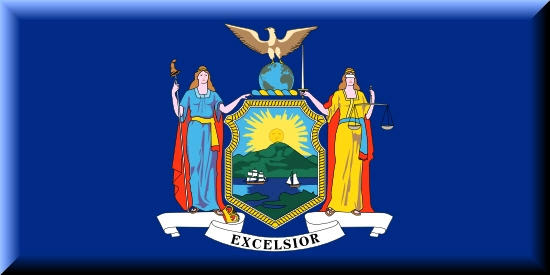
Nearby Labcorp Blood Testing facilities:
- Labcorp Center Distance: 0 m, 40 Winter St Ste 200, Rochester, Strafford County, NH, 3867
- Labcorp Center Distance: 5 m, 21 Clark Way, Somersworth, Strafford County, NH, 3878
- Labcorp Center Distance: 8 m, 750 Central Ave Ste E, Dover, Strafford County, NH, 3820
- Labcorp Center Distance: 19 m, 875 Greenland Rd Orchard Park, Portsmouth, Other, NH, 3801
- Labcorp Center Distance: 22 m, 19 Hampton Rd Ste 13, Exeter, Rockingham County, NH, 3833
- Labcorp Center Distance: 34 m, 101 Riverway Pl, Bedford, Hillsborough County, NH, 3110
- Labcorp Center Distance: 37 m, 49 Range Rd Ste 101, Windham, Rockingham County, NH, 3087
- Labcorp Center Distance: 38 m, 25 Pelham Rd Ste 103A, Salem, Rockingham County, NH, 3079
- Labcorp Center Distance: 39 m, 380 Merrimack St Ste B2, Methuen, Essex County, MA, 1844
- Labcorp Center Distance: 41 m, 200 Sutton St Ste 135, North Andover, Essex County, MA, 1845
- Labcorp Center Distance: 65 m, 6 Lexington St 2Nd Floor, Waltham, Middlesex County, MA, 2452
- Labcorp Center Distance: 68 m, 1400 Centre St Ste 208 2Nd Fl, Newton Center, Middlesex County, MA, 2459
- Labcorp Center Distance: 80 m, 140 W Boylston Dr, Worcester, Worcester County, MA, 1606
- Labcorp Center Distance: 82 m, 21 Eastern Avenue Suite G2, Worcester, Worcester County, MA, 1605
- Labcorp Center Distance: 95 m, 72 Cudworth Rd, Webster, Worcester County, MA, 1570
Nearby Quest Blood Testing facilities:
- Quest Center Distance: 16 m, 200 Griffin Rd Unit 12, Portsmouth, Rockingham County, NH, 03801-7114
- Quest Center Distance: 28 m, 14 Country Club Rd, Gilford, Belknap County, NH, 03249-6907
- Quest Center Distance: 30 m, 280 Pleasant St, Concord, Merrimack County, NH, 03301-2553
- Quest Center Distance: 32 m, 195 Mcgregor Street, Manchester, Hillsborough County, NH, 03102-3748
- Quest Center Distance: 35 m, 160 South River Road, Bedford, Hillsborough County, NH, 03110-5956
- Quest Center Distance: 37 m, 62 Brown Street, Haverhill, Essex County, MA, 01830-6790
- Quest Center Distance: 39 m, 45 Stiles Rd Ste 102, Salem, Rockingham County, NH, 03079-2850
- Quest Center Distance: 44 m, 138 Haverhill St, Andover, Essex County, MA, 01810-1509
- Quest Center Distance: 45 m, 300 Main St, Nashua, Hillsborough County, NH, 03060-4635
- Quest Center Distance: 48 m, 700 Rogers Street, Lowell, Middlesex County, MA, 01854-3571
- Quest Center Distance: 52 m, 39 Village Square, Chelmsford, Middlesex County, MA, 01824-2743
- Quest Center Distance: 61 m, 22 Mill Street, Suite 107, Arlington, Middlesex County, MA, 02476-4738
- Quest Center Distance: 65 m, 79 Erdman Way, Leominster, Worcester County, MA, 01453-0000
- Quest Center Distance: 66 m, 1180 Beacon St Ste 1D, Brookline, Norfolk County, MA, 02446-3885
- Quest Center Distance: 67 m, 319 Longwood Ave, Boston, Suffolk County, MA, 02115-5728
- Quest Center Distance: 71 m, 391 West Street, Keene, Cheshire County, NH, 03431-0000
- Quest Center Distance: 73 m, 500 Congress St Ste 1E, Quincy, Norfolk County, MA, 02169-0908
- Quest Center Distance: 75 m, 340 Wood Rd, Suite 302, Braintree, Norfolk County, MA, 02184-2410
- Quest Center Distance: 77 m, 851 Main Street, S. Weymouth, Norfolk County, MA, 02190-2409
- Quest Center Distance: 79 m, 335 Morse St, 1St Floor, Norwood, Norfolk County, MA, 02062-5034
- Quest Center Distance: 82 m, 100 Mlk, Jr. Blvd, Worcester, Worcester County, MA, 01608-1220
- Quest Center Distance: 83 m, 210 Quincy Ave, Brockton, Plymouth County, MA, 02302-2864
- Quest Center Distance: 87 m, 10 Commercial St, Foxboro, Norfolk County, MA, 02035-2509
- Quest Center Distance: 96 m, 57 Long Pond Rd, Plymouth, Plymouth County, MA, 02360-2670
Rochester New York Hormone Replacement Therapy Services
Hormone Optimization is among the latest in a line of new medical approaches to health and longevity that are available to patients today. Hormone Balance is one of the keys to maintaining wellness throughout the lifespan, but keeping this balance becomes more difficult with every passing year beyond the age of thirty.
At the Conscious Evolution Institute, it is our passion to help our patients feel better and improve their longevity by correcting Hormone Imbalance and improving physiological function through the use of HRT Therapy Solutions such as Human Growth Hormone Therapy and Testosterone Replacement. Our clinic is board certified, and licensed to provide HRT Services to patients all across America.
Our Hormone Clinic acheives our goals through the use of affiliate medical professionals located in Rochester and all across the United States that can acquire the necessary preliminary medical information that gives us the ability to issue you a highly accurate and confidential diagnosis.
If you are interested in learning more about the benefits of Hormone Therapy and the pros and cons of Hormone Replacement, we encourage you to contact us with any questions that you may have, or to set up an appointment with one of the affiliates of our Hormone Clinic.
Rochester New York Hormone Replacement Therapy for HGH Restoration
One of the primary HRT Treatment options that we provide at the Conscious Evolution Institute is HGH Therapy. Human Growth Hormone is the cornerstone of healthy physiological function, and is necessary for human cells to respond to the needs of the tissue and organs of the body. Beyond around 30 years of age, men and women start to experience Age-Related HGH Decline. Over time, people start to experience a drop in physiological function, which results in a litany of health issues that are reflected all throughout the human body, including, but not limited to:
Fatigue
Increased Belly Fat and Overall Weight
Thinning Hair
Depression
Mildly Impaired Memory and Cognitive Ability
Slower Recovery from Injury
Trouble Sleeping
Reduced Strength
Increased Susceptibility to Infection and Illness
Every patient responds to Declining Growth Hormone Levels in their own way, but the more severe the deficiency, the more likely that these symptoms will manifest, and the more severe that those symptoms will be. With Bio-Identical Human Growth Hormone Injections, it is possible to reduce the impact of HGH Deficiency on the human body by restoring adequate Hormone Levels through the use of Subcutaneous Growth Hormone Injections.
With these daily injections, it is possible to enhance wellness for patients suffering from Hypogonadism, allowing them to take the steps necessary to further improve their health and enhance their life.
Also ask about our Sermorelin Therapy Program. Sermorelin is another weapon at our disposal vs. HGH Deficiency, which has been shown to be equally as effective at restoring normal HGH levels, in this case by stimulating the production of natual HGH by the pituitary. If you are interested in Sermorelin Injections in Rochester, or how Sermorelin compares to HGH Therapy, we'd be happy to fill you in on the details, and how they apply to your personal care program!
Rochester New York Testosterone Creams, Injections, and Patches for Hypogonadism and Low-T
Testosterone Deficiency is becoming increasingly common among men in the United States. A number of factors contribute to this increase in Low-T Diagnosis, and increased awareness of the symptoms of Andropause have led more and more men to seek out reputable Hormone Clinics that offer Testosterone Therapy.
Low-T is well-known for its impact on normal and healthy sexual desire and function among men, as well as its catabolic effect upon muscle mass and strength, but Low-T is also associated with a number of other symptoms, including anxiety, impaired wellbeing, increased body mass, reduced cardiovascular capacity and function, increased risk of heart disease, and lack of energy. Our Low-T Doctors can assess your need for Andropause Treatment and ship Legal Online Testosterone Products to you at competitive prices.
Rochester New York Information
The city of Rochester is located in Northwest New York, and rests partially upon the southern bank of Lake Ontario. The city belongs to a larger metropolitan area which stretches across a number of counties, including Wayne, Orleans, Ontario, Livingston, Genesee, and Monroe County. All in all, the metro Rochester region has a population of more than one million residents. The city goes by a number of nicknames.
Originally, the city was nicknamed the Flour City, because it was an important location for the manufacture of flour that arrived from regional agricultural efforts early in the history of the city. Rochester is also referred to as the Flower City, because of the historical prominence of gardens and plant nurseries in and around the city, which developed after the initial boom of wheat processing.
As the city has grown and diversified over the course of the 20th century, Rochester has also come to be known as the World's Image Center, because of the prominence of high-tech industry revolving around the field of optics and imaging. Both Xerox and Kodak have a strong economic presence in the city, and both the Rochester Institute of Technology and the University of Rochester have active STEM Departments dedicated to furthering the science of optics and creating new imaging specialists.
Today, the Rochester Economy continues to revolve around education and high technology, though many other companies have established themselves in the city, including Hickey Freeman, Genessee Brewing Company, and ESL Federal Credit Union.
Rochester Living and Culture
Neighborhoods in Rochester include Upper Monroe, University-Atlantic, Marketview Heights, Highland Park, Grove Place, Charlotte, Browncroft, Beechwood, and the 14621 Community. Some suburbs of Rochester are Irondequoit, Brighton, Webster, Pittsford, Fairport, Spencerport, and Hilton.
Most of the fun things to do in Rochester center on the East End District, which is home to both the Eastman Theater and the Eastman School of Music. The second most active area for entertainment in Rochester is the South Wedge, which primarily serves the younger population of Rochester, including working professionals and University of Rochester students. Major events in Rochester include the Irish Festival, the Rose Festival, and the Xerox Rochester International Film Festival.
All About Rochester, New York Geographic Area
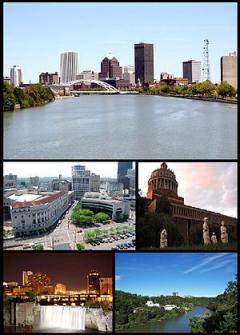
Rochester is a city in Monroe County, New York, south of Lake Ontario in the United States. Known as The World's Image Centre, it was also once known as The Flour City, and more recently as The Flower City. It is the county seat for Monroe County.
Rochester's city population according to the 2010 census is approximately 210,565, making it New York's third most populous city after New York City and Buffalo. It is at the center of a larger metropolitan area which encompasses and extends beyond Monroe County and includes Genesee County, Livingston County, Ontario County, Orleans County and Wayne County. This area, which is part of the Western New York region, had a population of 1,054,323 people at the time of the 2010 Census. As of July, 2011, the Census estimates indicated that this population rose to 1,055,278 .
Rochester was one of America's first "boomtowns" and rose to prominence initially as the site of many flour mills located on the Genesee River, then as a major manufacturing hub. Rochester is now an international center of higher education, as well as medical and technological development. The region is known for many acclaimed universities, and several of them (notably the University of Rochester and the Rochester Institute of Technology) are nationally renowned for their research programs. In addition, Rochester has been and continues to be the site of many important inventions and innovations in consumer products. The Rochester area is currently home to corporations such as Kodak, Bausch & Lomb and Xerox that conduct extensive research and manufacturing in the fields of industrial and consumer products. The Rochester metropolitan area is the second largest regional economy in New York State according to the U.S. Internal Revenue Service, after the New York City metropolitan area.
Rochester was ranked as the sixth 'most livable city' among 379 U.S. metropolitan areas in the 25th edition (2007) of the Places Rated Almanac. The Rochester area also received the top ranking for overall quality of life among U.S. metros with populations of more than 1 million in a 2007 study by Expansion Management magazine. In the same study, Expansion Management rated the area's public schools as sixth best nationwide. In 2010 Forbes rated Rochester as the third best place to raise a family. In 2012 Kiplinger rated Rochester as the fifth best city for families, citing low cost of living, top public schools, and a low jobless rate.
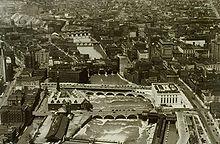
The Seneca tribe of First Nations (Native Americans) lived in the area in and around Rochester until their land rights were removed in 1797. Settlement before the Seneca tribe is unknown.
Development of modern Rochester followed the American Revolution, and forced cession of their territory by the Iroquois after the defeat of Great Britain. Allied with the British, four major Iroquois tribes were essentially forced from New York. As a reward for their loyalty to the British Crown, they were given a large land grant on the Grand River in Canada.
On November 8, 1803, Col. Nathaniel Rochester (1752 ae1831), Maj. Charles Carroll, and Col. William Fitzhugh, Jr. (1761 ae1839), all of Hagerstown, Maryland, purchased a 100-acre (ca. 40 ha) tract from the state in Western New York along the Genesee River. They chose the site because its three cataracts on the Genesee offered great potential for water power. Beginning in 1811, and with a population of 15, the three founders surveyed the land and laid out streets and tracts. In 1817, the Brown brothers and other landowners joined their lands with the Hundred Acre Tract to form the village of Rochesterville.
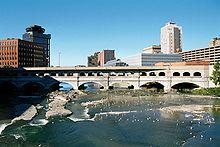
By 1821, Rochesterville was the seat of Monroe County. In 1823, Rochesterville consisted of 1,012 acres (4 km2) and 2,500 residents, and the Village of Rochesterville became known as Rochester. Also in 1823, the Erie Canal aqueduct over the Genesee River was completed, and the Erie Canal east to the Hudson River was opened. (In the early 20th century, after the advent of railroads, the presence of the canal in the center city was an obstacle; it was re-routed south of Rochester.) By 1830, Rochester's population was 9,200 and in 1834, it was re-chartered as a city.
Rochester was first known as "The Young Lion of the West", and then as the "Flour City". By 1838, Rochester was the largest flour-producing city in the United States. Having doubled its population in only ten years, Rochester became America's first "boomtown".
By the mid-19th century, as the center of the wheat-processing industry moved west with population and agriculture, the city became home to an expanding nursery business, giving rise to the city's second nickname, the "Flower City." Large and small nurseries ringed the city, the most famous of which was started in 1840 by immigrants George Ellwanger from Germany and Patrick Barry from Ireland.
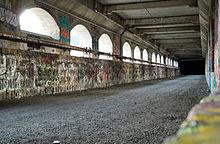
In 1847, Frederick Douglass founded the abolitionist newspaper The North Star in Rochester. Douglass, a former slave and an antislavery speaker and writer, gained a circulation of over 4,000 readers in the United States, Europe and the Caribbean. The North Star served as a forum for abolitionist views. The Douglass home burnt down in 1872, but a marker for it can be found in Highland Park off South Avenue. The city was also home to Susan B. Anthony, an abolitionist who became active in the women's rights movement. At the end of the 19th century, anarchist Emma Goldman lived and worked in Rochester for several years, where she championed the cause of labor in Rochester sweatshops. Rochester was also home to significant unrest in labor, race, and antiwar protests.
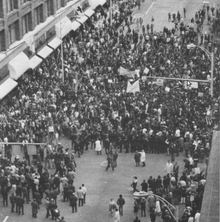
After the Civil War, Rochester had an expansion of new industries in the late 19th century, founded by migrants to the city, such as inventor and entrepreneur George Eastman, who founded Eastman Kodak, and German immigrants John Jacob Bausch and Henry Lomb, who combined technical and financial expertise to launch Bausch & Lomb in 1861. Not only did they create new industries and thousands of jobs, but Eastman became a major philanthropist, developing and endowing the University of Rochester, its Eastman School of Music and other local institutions. He also supported the development of the Massachusetts Institute of Technology (MIT) and Tuskegee University in the late 19th and early 20th centuries.
In the early 20th century, Rochester became a center of the garment industry, particularly men's fashions. It was the base of enterprises such as Bond Clothing Stores, Fashion Park Clothes, Hickey Freeman, and Stein-Bloch & Co. The carriage maker James Cunningham and Sons founded a pioneer automobile company - Cunningham.
The population reached 62,386 in 1870, 162,608 in 1900 and 295,750 in 1920. By 1950, the population had reached a high of 332,488. In 1950, the Census Bureau reported Rochester's population as 97.6% white and 2.3% black. With industrial restructuring in the later 20th century, and the decline of industry and jobs in the area, by 2010, the population had declined to 210,565 in the city, although the metropolitan area was considerably larger.
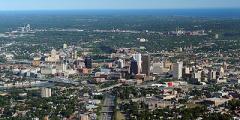
Rochester is at 43 °9 a²56 a³N 77 °36 a²41 a³W / 43.16556 °N 77.61139 °W / 43.16556; -77.61139 (43.165496, -77.611504). The city is east of Buffalo, west of Syracuse and sits on Lake Ontario's southern shore. The Genesee River bisects the city. New York (city) is to the southeast.
According to the United States Census Bureau, the city has a total area of 37.1 square miles (96 km2), of which 35.8 square miles (93 km2) of it is land and 1.3 square miles (3.4 km2) of it (3.42%) is water.
Rochester's geography was formed by the ice sheets during the Pleistocene epoch. The retreating ice sheets reached a standstill at what is now the southern border of the city, melting at the same rate as they were advancing, depositing sediment along the southern edge of the ice mass. This created a line of hills, including (from west to east) Mt. Hope, the hills of Highland Park, Pinnacle Hill, and Cobb's Hill. Because the sediment of these hills was deposited into a proglacial lake, they are stratified and classified as a "kame delta". A brief retreat and readvance of the ice sheet onto the delta deposited unstratified material there, creating a rare hybrid structure called a "kame moraine".
The ice sheets also created Lake Ontario (one of the five fresh-water Great Lakes), the Genesee River with its waterfalls and gorges, Irondequoit Bay, Sodus Bay, Braddock Bay, Mendon Ponds, numerous local streams and ponds, the Ridge, and the nearby Finger Lakes.
According to the City of Rochester, the city has 537 miles (864 km) of public streets, 585 miles (941 km) of water mains, 44 vehicular and eight pedestrian bridges, 11 public libraries, two police stations (one for the east side, one for the west), and 15 firehouses. The principal source of water is Hemlock Lake, which, with its watershed, is owned by the state of New York. Other water sources include Canadice Lake and Lake Ontario. The 30-year annual average snowfall is 95.0 inches (241 cm).[not in citation given] The mean July temperature is 71.3 °F (21.8 °C) and the mean February temperature is 23.6 °F ( na4.7 °C). The high amount of snow that Rochester receives can be accounted for by the city's proximity to Lake Ontario (see lake effect).
Rochester lies in the Humid continental climate zone (Koppen Dfb) and has four distinct seasons, with often cold and snowy winters. Autumn features brilliant foliage colors, and summer sees generally comfortable temperatures that usually stay in the 80-85 °F (upper 20s °C) range accompanied by moderate to high humidity. Heat waves are not uncommon during a typical summer. Precipitation is plentiful year round.
According to the 2010 Census, the city's population was 43.7% White, 41.7% Black or African American (38.8% non-Hispanic Black or African American alone), 0.5% American Indian and Alaska Native, 3.1% Asian, 0.0% Native Hawaiian and Other Pacific Islander, 6.6% from some other race and 4.4% from two or more races. 16.4% of the total population were Hispanic or Latino of any race, mostly made up of Puerto Ricans. Non-Hispanic Whites were 37.6% of the population in 2010.
As of 1997, Rochester had the largest per capita deaf population in the United States.
There were 88,999 households of which 30.0% had children under 18 living with them, 25.1% were married couples living together, 23.3% had a female householder with no husband present, and 47.0% were non-families. 37.1% of all households were made up of individuals and 9.2% had someone living alone 65 or older. The average household size was 2.36 and the average family size was 3.19.
The city population was 28.1% under 18, 11.6% from 18 to 24, 32.2% from 25 to 44, 18.1% from 45 to 64, and 10.0% who were 65 or older. The median age was 31. For every 100 females there were 91.6 males. For every 100 females 18 and over, there were 87.3 males.
The median income for a city household was $27,123, and the median family income was $31,257. Males had a median income of $30,521, versus $25,139 for females. The per capita income for the city was $15,588. About 23.4% of families and 25.9% of the population were below the poverty line, including 37.5% of those under age 18 and 15.4% of those age 65 or over.
In 2006 Rochester had 1259.6 reported violent crimes per 100,000 residents, compared to a national rate of 553.5. For 2006, Rochester had 827 personal crime incidents per 100,000 and 7,173 property crime incidents per 100,000.
With 100 being the national average, Rochester scores the following:
Personal Crime Risk - 170 Property Crime Risk - 134
In 2008, Rochester reported 42 murders (20.5 per 100,000 people), 98 sexual assaults, 1,059 robberies, 1,103 assaults, 2,808 burglaries, 7,060 larceny thefts, and 1,262 auto thefts.
Rochester is home to a number of Fortune 1000 and international businesses, including Eastman Kodak, as well as several national and regional companies, such as Bausch & Lomb. Xerox was founded in Rochester in 1906 as The Haloid Company, and retains a significant presence in Rochester, although its headquarters are now located in Norwalk, Connecticut. The Gannett newspaper company and Western Union were founded in the Rochester area by Frank Gannett and Hiram Sibley respectively but have since moved to other cities.
Because of the high prevalence of imaging and optical science among the industry and the universities, Rochester is known as the world capital of imaging. The Institute of Optics of the University of Rochester and the Rochester Institute of Technology in nearby Henrietta both have imaging programs. In 2006, the University of Rochester became the largest employer in the Rochester area, surpassing Kodak.
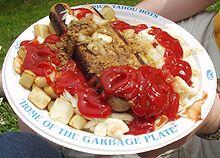
One food product that Rochester calls its own is the "white hot", a variant of the hot dog or smoked bratwurst made by the local Zweigle's company and other companies. Another local specialty is the "garbage plate," first served at Nick Tahou Hots and traditionally includes home fries, mac salad, meat sauce, onions, mustard and choice of hot dog or hamburger. Many area restaurants feature copies or variations of the "garbage plate" but cannot call it such because of trademarks. Instead, the word "plate" is commonly used as a general term. Rochester was home to French's Mustard, whose address was 1 Mustard Street.
Genesee Brewing Company, maker of the Genesee beers, Honey Brown, Dundee Ales & Lagers and Labatt Blue Lime also calls Rochester home.
The RagRº brand of pasta sauce was originally produced in Rochester.
Other local franchises include: Bill Gray's (a hamburger/hot dog joint that lays claim to having "The World's Greatest Cheeseburger"), Tom Wahl's, DiBella's, Pontillo's Pizzeria and Abbott's Frozen Custard. Dinosaur Bar-B-Que, which originated in Syracuse, also operates their second franchise downtown in the former Lehigh Valley Railroad station on the Genesee River.
As of February 2008, the top ten tallest buildings in the city are:
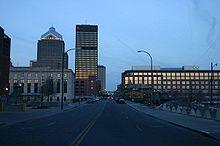
Several companies have corporate headquarters in Rochester.
Locally founded corporations that have since moved their headquarters to other states include French's, Gannett, Western Union, Champion and Xerox. Humor website eBaum's World was also started in Rochester. Companies that moved their headquarters from the city of Rochester to the suburbs include Wegmans (Gates, NY) and Paychex (Penfield, NY).
Rochester is governed by a "strong mayor" serving as chief executive of city government and a city council consisting of 4 district members and 5 at-large members. Mayor Thomas Richards, a Democrat, was elected in a special city-wide election on March 29, 2011 after the two-term elected mayor, Robert Duffy was elected Lieutenant Governor of New York State in November 2010.
The city's police department is the Rochester Police Department, as of 2012[update] headed by Chief of Police James Sheppard.
Enforcement of property code violations in Rochester is handled by the Neighborhood Empowerment Team, or NET. Rather than utilizing a centralized code-enforcement office, 10 sectors in Rochester are assigned a total of six NET offices by the city government. Some[who?] have complained about the lack of consistency in the resulting manner and severity of enforcement. On July 16, 2008, the city announced that two of the NET offices would be closed and another relocated, due to what it had found to be the high cost and low value of operating the decentralized network.
The city of Rochester is protected by the 500 paid, professional firefighters of the Rochester Fire Department(RFD). The RFD operates out of 15 Fire Stations, located throughout the city in 3 Battalions, and maintain a fire apparatus fleet of 11 Engines, 5 Trucks, 2 Quints, 1 Rescue, 2 Midi Units, 2 Haz-Mat. Units, and numerous other special, support, and reserve units.
Suburbs of the city include: Brighton, Brockport, Chili, Churchville, East Rochester, Fairport, Gates, Greece, Hamlin, Henrietta, Hilton, Honeoye Falls, New York, Irondequoit, Mendon, Ogden, Parma, Penfield, Pittsford, Riga, Rush, Scottsville, Spencerport, Webster, Victor and Wheatland.
Rochester has a number of neighborhoods, including the 19th Ward, 14621 Community, Beechwood, Browncroft, Cascade District, Cobbs Hill, Charlotte, Corn Hill, Dewey, Dutchtown, Edgerton, Ellwanger-Barry, German Village, Grove Place, High Falls District, Highland Park, Dutchtown Maplewood (10th Ward), Marketview Heights, Mt. Read, Northern Edge dead link,Otis-Lyell, Park Avenue, Plymouth-Exchange, Southwest, East End, South Wedge, Swillburg, Susan B. Anthony, University-Atlantic, Upper Monroe, and more are all recognized communities with various neighborhood associations. There are also living spaces in Downtown Rochester.
The Browncroft neighborhood is built on the former nursery grounds of the Brown Brothers nursery. The business district situated on Winton Rd has a mix of restaurants and shops. The neighborhood borders the nearby Tryon and Ellison Parks. The Browncroft Historic District was listed on the National Register of Historic Places in 2004.
Extending across much of the north-central cityscape of Rochester, now including parts of the old Hudson Avenue and North Clinton neighborhoods, is the 14621 community. Today this neighborhood is predominantly African American and Hispanic, this community suffered being the center of the 1964 riots. The riots did produce some benefits in the long run: the north-central area has been the site of ongoing urban renewal projects since the late 1960s, and, as noted by JULY ao64 filmmakers Carvin Eison and Chris Christopher, inspired the development of such important African American organizations such as The Urban League of Rochester as well as Rochester aos first anti-poverty organization (Action for a Better Community), and black community activist organization Freedom, Integration, God, Honor, Today (F.I.G.H.T.) founded by Rev. Franklin Florence and Deleon McEwen, the latter was its first president. The establishment of this program came the assistance of Saul Alinsky. However, the neighborhood is still considered the most dangerous part of Rochester and is blighted by crime, drugs and gang activity.
Once an Italian-American neighborhood, there have recently been efforts by to improve the quality of life in this neighborhood. It is known largely for its crime, especially instances of prostitution and drug sales.
The 19th Ward is a southwest neighborhood bordered by Genesee Street, West Avenue, the Erie Canal, and is across the river from the University of Rochester. Now known by its slogan "Urban by Choice," in the early 19th century the area was known as Castle Town, after Castle Inn, a tavern run by Colonel Isaac Castle. By the early 1820s however, the area became overshadowed by developments in the north that would later become downtown Rochester. Due to a tumultuous bend in the Genesee river, the area was home to skilled boatsmen that assisted boats traveling north to Rochester and the area was consequently known during this time as "The Rapids". In the 1890s, as Rochester expanded, the area became a prosperous residential area that thrived as the city grew. By 1930 it was a booming residential area for doctors, lawyers, and skilled workers; it includes the still prestigious Sibley Tract development. Homes in the originally upper-class neighborhood typically have gumwood trim, leaded glass, fireplaces, hardwood floors, and open porches. In the 1960s, property values declined as the population of Rochester did, the area experienced white flight accelerated by school busing, blockbusting, and race riots downtown, and crime increased, with violence, drug use, and neglected property further diminishing property values.
The 19th Ward has had an active community association since 1965, and is known for its ethnic, class, and cultural diversity.[vague] The current "Brooks Landing" development is successfully bringing new economic development to the community including an 88-room hotel, 20,000-square-foot (1,900 m2) office building, 11,000 square feet (1,000 m2) of new retail, and Boulder Coffee shop.
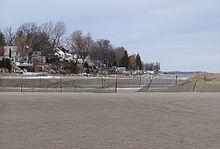
Charlotte (shar-LOT) is a lake front community in Rochester bordering Lake Ontario. It is home to Ontario Beach Park, commonly known as Charlotte Beach, which is a popular summer destination for Rochesterians. A new terminal was built in 2004 for the Rochester-to-Toronto ferry service and was later sold after the ferry ceased operations in 2005. The Port of Rochester terminal still exists and has since been completely revamped. It now houses a popular high-end restaurant and event facility aePier 45 at The Port, the restaurant Cheeburger Cheeburger, the restaurant California Rollin', a coffee shop named The Nutty Bavarian, and an Abbott's Frozen Custard.
The Corn Hill neighborhood near downtown is one of the nation's best preserved Victorian neighborhoods and a center for art. It is also home to Corn Hill Landing, a shopping and housing strip located on the Genesee River. The annual Corn Hill Art Festival, a two-day event held the weekend after the 4th of July, is one of the city's most popular gatherings for the display of art.
Located less than one and one-half miles from downtown, Upper Monroe encompasses 17 streets with 1400 households and approximately 3300 residents. Cobbs Hill Park, with its beautiful reservoir, tennis courts and athletic fields, forms the southeastern boundary of this neighborhood. Highland Park, world-renowned for its annual Lilac Festival, also is within walking distance. The Upper Monroe Neighborhood Association (UMNA) is a not-for-profit advocacy group representing the residents and property owners of the Upper Monroe neighborhood. Their goals are to ascertain the needs and concerns of the neighborhood and take positive action to address those needs and concerns. The neighborhood is also home to a number of small, local businesses including: Hardpact, Huey's Hair Company, Monty's Krown, Jeremiah's Tavern, and Park Ave. Pets.
The East End is a residential neighborhood in Downtown Rochester but also the main nightlife district. The Eastman Theatre and the Eastman School of Music are in the East End, along with the Little Theatre, an independent film theatre and many clubs, bars and high-end restaurants.
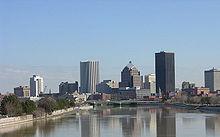
Maplewood is a northwest neighborhood located south of Eastman Business Park and between the Genesee River and Dewey Avenue. Much of the area's charm comes from the use of parkways as well as parks and greenspace bordering the river. These features are the result of plans designed by Frederick Law Olmsted. The Maplewood Rose Garden is the second largest Rose Test Garden in the United States. The Maplewood Historic District was listed on the National Register of Historic Places in 1997.
Lining the streets of Park Avenue are cafes, shops, pubs and restaurants. In a broader view, the total area surrounding University Avenue aeknown as the Neighborhood of the Arts aeis one of the most culture and art-rich sections of the city. Located here are the Village Gate, Memorial Art Gallery, School of The Arts, Rochester Museum and Science Center, Rochester Public Market, ARTWalk, George Eastman House, and high-end residential streets such as Granger Place, East Boulevard, Douglas Road, Westminster Road, and Berkeley Street.
Also known by the acronym PLEX, the Plymouth-Exchange neighborhood provides affordable housing for lower income families. Also home to many University of Rochester students, both grad and undergrad, it has a richly knit community and an active neighborhood association.
The South Wedge neighborhood dates back to 1827, prior to the incorporation of Rochester as a city. The area is bordered by Byron Street in the north, South Clinton Avenue and Interstate 490 on its east, Highland Park on its south, and The Genesee River on the west. Construction of the Erie Canal (the old canal bed which went by the neighborhood is now used by Interstate 490) brought workers to the area, who set up camps for the months that it took to complete this section of the canal. This racially integrated neighborhood is one of the neighborhoods in Rochester currently undergoing the process of gentrification, partially due to a recent increase in homeownership in the area. A lot of young people live in this area. The Linden-South Historic District in South Wedge was listed on the National Register of Historic Places in 2009.
This neighborhood is a Preservation District on the National Register of Historic Places, known as the Madison Square-West Main Street Historic District. It encompasses a three-and-one-half block area within walking distance from downtown Rochester, and comprises residential, commercial and industrial buildings. The center of the residential area is Susan B. Anthony Square, a 0.84-acre (3,400 m2) park shown on city maps from 1839, which was designed by the famous Olmstead Brothers. Also within the neighborhood is the Susan B. Anthony House, which was the suffragist aos residence for the last decades of her life, now a museum, as well as the Cunningham Carriage factory built in 1848 on Canal Street. James Cunningham Son & Co. sold more carriages in the United States in the 1880s than all other manufacturers combined. The Canal Street property, which still stands, remained Cunningham's headquarters for more than 100 years.
This wedge-shaped piece of the city is bordered by S. Clinton Avenue, Field St, and Interstate 490. The neighborhood received its moniker when a 19th century Rochester pig farmer utilized the area to collect swill for his swine. The neighborhood association humorously honors its roots by using street signs featuring the Swillburg Pig. The area has one of the highest rates of homeownership in the city and is currently undergoing gentrification as well.
The local elementary school is #35, Field Street, which often sponsors a community garden in its courtyard on Pinnacle Street.
Running east from Union Street just north of Main Street, Marketview Heights is best known as the location of the Public Market, which offers a variety of groceries and other goods from marketeers from farms and shops from surrounding areas, primarily on the weekends.
Homestead Heights is located in northeast Rochester. It is bordered on the west by Goodman Street, on the north by Clifford Avenue, on the south by Bay Street, and on the east by Culver Road, which is also the border between the city and the town of Irondequoit. The neighborhood is a mix of residential and commercial. Real estate values are higher on the eastern end of the neighborhood near the Irondequoit border. The neighborhood is approximately 2 ae21 ae4 miles west of the Irondequoit Bay.
The City of Rochester is served by the Rochester City School District which encompasses all public primary and secondary education. The district is governed by a popularly elected seven-member Board of Education. There are also parochial and private primary and secondary schools located within the city. Rochester City Schools consistently post below-average results when compared to the rest of New York State, although on-time graduation rates have improved significantly during the past three years.
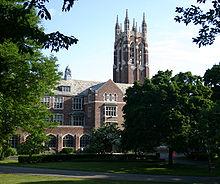
Only two institutions of higher learning, the University of Rochester and Colgate Rochester Crozer Divinity School, operate primarily within the Rochester city limits.
Additionally, Monroe Community College and SUNY Brockport operate campuses in downtown Rochester. These are the Damon City Campus and SUNY MetroCenter, respectively. Rochester Institute of Technology operates a student art gallery on College Avenue. Ithaca College's Department of Physical Therapy leases part of the Colgate Rochester Crozer Divinity School facility for teaching and research. The Cornell University School of Industrial and Labor Relations maintains an office on Highland Avenue as well.
There are four institutions that began operations in the city, but subsequently moved to Rochester's inner-ring suburbs:
Rochester's colleges are all part of the Rochester Area Colleges consortium.
Rochester was host of the Barleywood Female University, a short-lived women's college from 1852 to 1853.
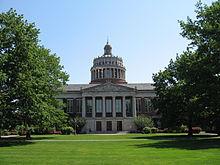
The University of Rochester (U of R), was ranked as the 35th-best university in the nation by U.S. News & World Report for 2011 and was deemed "one of the new Ivies" by Newsweek. The nursing school has received many awards and honors and the Simon School of Business is also ranked in the top 30 in many categories.
The university is also home to the Eastman School of Music, which was ranked the number one music school in America. It was founded and endowed by George Eastman in his years as a philanthropist. He also contributed greatly to the University of Rochester from wealth based on the success of Eastman Kodak.
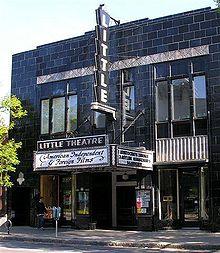
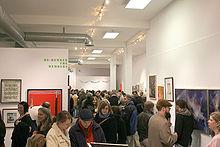
The city of Rochester is home to numerous cultural institutions. These include the Garth Fagan Dance, the Rochester Philharmonic Orchestra, George Eastman House International Museum of Photography and Film, Memorial Art Gallery, Rochester Contemporary Art Center, Rochester Museum & Science Center, the Rochester Broadway Theater League, Strong National Museum of Play, the Strasenburgh Planetarium, Hochstein School of Music and Dance, and numerous arts organizations. Geva Theatre Center is the city's largest professional theatre. The East End Theater is located on East Main Street in the theater district. The Rochester Association of Performing Arts is a non-profit organization that provides educational theater classes to the community. Local cooking celebrities, the Calamari Sisters, will be performing their well-known cooking show until September 2012.
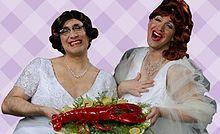
Rochester's East End district, located downtown, is well known as the center of the city's nightlife. It is the stopping point for East Avenue, which along with the surrounding streets is crowded with nightclubs, lounges, coffee shops, bars, and high-end restaurants. The Eastman School of Music, one of the top musical institutes in the nation, and its auditorium are also located within the neighborhood. The Eastman Theatre now plays host to the Rochester Philharmonic Orchestra and other musical/drama events.
There are other, smaller enclaves of after-hours activity scattered across the city. Southeast is the heart of Rochester's thriving arts scene, particularly in and around the Park Avenue neighborhood (which is known for its many coffee shops, cafes, bistros and boutique shopes). Nearby on University Avenue can be found several plazas like the Village Gate which give space to trendy bars, restaurants and art galleries that stay open late into the night. Monroe Avenue, several streets over, is packed with pubs, small restaurants, smoke shops, theaters and several clubs as well as cigar bars and hookah lounges. All of these neighborhoods are home to many artists, musicians, students and Rochester's large LGBT community.
The South Wedge district, located directly below downtown, has seen significant gentrification in recent years and now is the site of many trendy cafes and bars that serve the student community attending the University of Rochester several blocks away from the heart of the neighborhoods. The wedge is quickly becoming one of the most vibrant areas within the city limits, its numerous nightspots keeping the streets busy with college students and young professionals (many of whom live there due to the abundance of affordable housing, thriving nightlife and proximity to many of the region's major hospitals, parks and colleges)
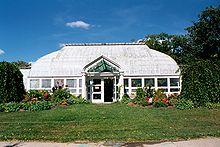
Rochester is known for its parks, including Highland, Cobb's Hill, Durand Eastman, Genesee Valley, Maplewood, Edgerton, Seneca, and Ontario Beach; four of these were designed by famed landscape architect Frederick Law Olmsted. The city's Victorian-era Mt. Hope Cemetery includes the final resting places of Susan B. Anthony, Frederick Douglass, and George B. Selden. Other scenic sites are Holy Sepulchre and neighboring Riverside Cemetery.
The city has 13 full-time recreation centers, 19 swimming programs, 3 artificial ice rinks, 66 softball/baseball fields, 47 tennis courts, 5 football fields, 7 soccer fields, and 43 outdoor basketball courts. As a legacy of its time as "The Flower City", Rochester hosts a Lilac Festival for ten days every May, when nearly 400 varieties of lilacs bloom, and 100,000 visitors arrive.
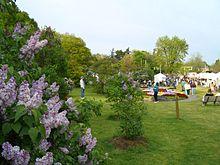
Rochester hosts a number of cultural festivals every year. While there are events that occur during the winter, Rochester's main festival season begins in the spring and carries on throughout the summer. Events of note include:
The Democrat and Chronicle is Rochester's main daily newspaper. The Daily Record, a legal, real estate and business daily, has published Monday through Friday since 1908. Insider magazine (owned by the Democrat and Chronicle), "City" newspaper and the "Freetime" entertainment magazine are free, weekly publications. Rochester Business Journal is the weekly business paper of record. "The Good Life Magazine" is a free bi-monthly publication. There is also a grassroots, democratically run, Independent Media Center called Rochester Indymedia. Media addressing the needs of Rochester's large African American population include "About... time", and "Minority Reporter", which has an associated news journal for the area's Latin American population, "La Voz".
Rochester is served by eight broadcast television stations:
Rochester is served by multiple AM and FM radio stations including WXXI (Public Radio; AM News and Talk, FM Classical and Fine Arts), WCMF (Rock and Roll), WBEE (Country), WPXY (Contemporary Hit Radio), WLGZ (Classic Hits), WROC (Sports), WRMM (Adult Contemporary), WDKX (Urban Contemporary Radio), WJZR (smooth jazz), WBER (alternative, independent, and local), WRUR (adult album alternative), WZNE (modern rock), and WHAM (News and Talk Radio), among others.
Time Warner Cable provides Rochester with cable-fed internet service, digital and standard cable television, and YNN Rochester, a 24-hour local news channel.
Rochester was served by the Rochester Post Express published by the Post Express Print Company from 1882 to 1923. In 1923 the paper merged with the Rochester News Corporation's Rochester Evening Journal to become Rochester Evening Journal and The Post Express and served the area from 1923 through 1937.
Rochester's evening paper for many years was the Times-Union, which merged operations with the Democrat and Chronicle in 1992, going defunct five years later.
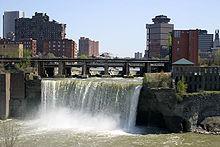
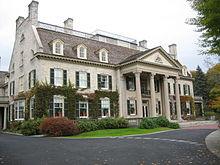
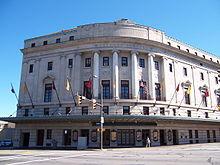
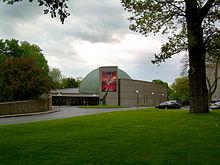
Rochester was named the top minor league sports market in the country by Street & Smith's Sports Business Journal in July 2005, the number 10 "best golf city" in America by Golf Magazine in 2007, and the fifth-best "sports town" in the country by Scarborough Research in September 2008.
Although Rochester is home territory to the Buffalo Bills and the Buffalo Sabres, Rochester has several professional sports teams of its own:
Among cities in North America with at least seven current professional teams, Rochester was determined in 2007 to be the only one whose teams all had cumulative winning regular season records.
The Rochester Red Wings baseball club, the AAA affiliate of the Minnesota Twins, play in the International League. The Rochester Americans ice hockey team, the AHL affiliate for the NHL Buffalo Sabres, are known as the "Amerks". The Rochester Rhinos soccer club have played for many years in the USL First Division, which is the second-highest level American soccer league.
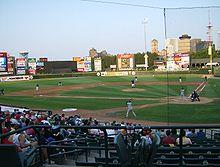
Lacrosse has seen some popularity in Rochester. The Rochester Knighthawks play box lacrosse in the National Lacrosse League during winter and spring. In outdoor lacrosse, the Rochester Rattlers were a charter member of Major League Lacrosse, but the franchise was transferred to the new Toronto Nationals (MLL) in 2009; the Rattlers will be re-established in 2011 with the transfer of the Chicago Machine franchise. Also during the summer months, the Rochester Greywolves, comprising mostly local talent, play box lacrosse in the semi-pro CanAm Lacrosse League.
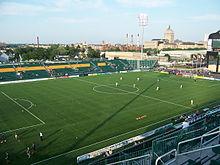
The Rochester Razorsharks, in the Premier Basketball League, have dominated competition and already have multiple championships; the Rochester Lancers (2010) have started up in indoor soccer and are looking to have similar success. In the past, the Rochester Brigade and Rochester Raiders indoor football teams have played in Rochester; the former was unsuccessful but the latter garnered two championships before folding in 2010. A new indoor football team, the Roc City Thunder, hopes to begin play in 2013.
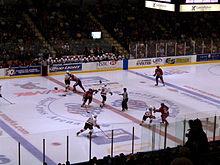
In women's sports, Rochester is the home of the Western New York Flash, 2011 Women's Professional Soccer champions. In prior years, the Rochester Ravens have competed in the semi-pro W-League under a few different names. The Filarets was a notable women's basketball team that played in the 1930s, 1940s and 1950s.
The city also has an independent pro-wrestling league: NWA Upstate.
The absence of a major pro sports team has not always been the case. From 1920 to 1925, Rochester was home to the Rochester Jeffersons, a charter member of the National Football League. From 1948 to 1957, the Rochester Royals played in the National Basketball Association, winning the NBA championship in 1951. In soccer, the Rochester Lancers played from 1970 to 1980 in the top-level North American Soccer League and became NASL champions in the 1970 season.
Since 1877, 29 teams in eight professional sports have represented Rochester, according to The Rochester Sports Project by local sports historian Douglas Brei. In spring 2006, Brei showed that Rochester's professional sports teams were collectively approaching 25,000 games played. That game was played on June 16, 2006, when Red Wings hosted the Indianapolis Indians at Frontier Field. He also reports that only six active franchises in the history of North American professional sports have played in the same city and same league continuously and uninterrupted since the 19th century: Chicago Cubs, Cincinnati Reds, Philadelphia Phillies, Pittsburgh Pirates, St. Louis Cardinals, and Rochester Red Wings.
Rochester has a rich history in golf dating back to the 19th Century. The area's oldest club, The Country Club of Rochester (CCR) was founded in 1896. Oak Hill Country Club, which is often included in America's Top 100 Courses is in the suburb of Pittsford. Oak Hill has hosted the Ryder Cup, Men's U.S Open, and PGA Championship to name a few. Locust Hill Country Club hosts the Wegman's LPGA Championship every year in late June. Numerous golf magazines have praised Rochester for its rich passion for the game and its high level of competition.
Almost all area college sports are played at the NCAA Division III level. The exception is the RIT men's ice hockey team, which moved up to the Division I level in 2005, and made it to the NCAA Frozen Four in 2010.
Among junior colleges, MCC is dominant[peacock term] in NJCAA Division II sports. They are also a D-III golf powerhouse and in addition won back to back national championships for women's lacrosse in '10 and '11.[peacock term].
Rochester is the largest Metropolitan Statistical Area in the U.S. which does not include at least one college or university participating at the NCAA Division I level in all sports.
Rochester is home to two men's rugby teams, the Rochester Aardvarks and the Rochester Colonials. Both have long histories, with the Aardvarks celebrating their 40th anniversary in 2006, and the Rochester Colonials celebrating 30 years upcoming in 2010. The Aardvarks are one of the few rugby teams in the country to own its own pitch: Aardvark Park in Henrietta, New York, while the Colonials play their matches in the downtown located soccer stadium. The Aardvarks and the Colonials both have hosted local and state-wide tournaments and the Rochester Colonials hosted the 2007 USA Rugby National Collegiate All-Star Championships, Rochester's first national tournament, as well as the 2009 NYS Rugby Upstates Tournament and the 2009 New York State High School Rugby Championships. Both teams participate in the annual Can-Am Rugby Tournament in Saranac Lake, New York in early August. Rochester also has a Women's Rugby club, the Rochester Renegades, who celebrated their 20th anniversary in 2008. The Renegades started the New York State Rugby Women's Division.
The Rochester Bicycling Club is a social and fitness bicycling club.
Rochester is also home to Rochester Rhythm the three time champions of the American Extreme Paintball League or AXBL.
The Rochester, NY Region EWGA chapter, homepage , organizes leagues, golf training, and golf events and networking for the area's amateur women golfers.
Monroe County supports two adult baseball (hardball) leagues - the Rochester chapters of the Men's Senior Baseball League (MSBL) and National Adult Baseball Association (NABA).
The Rochester Curling Club is the westernmost curling club in New York.
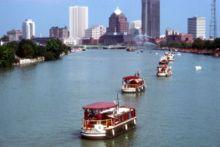
There is marine freight service at the Port of Rochester on Lake Ontario, which is connected to the Atlantic Ocean via the Saint Lawrence Seaway.
A short-lived, high-speed passenger/vehicle ferry Spirit of Ontario I built in Australia, nicknamed The Breeze or The Fast Ferry, linked Rochester to Toronto across Lake Ontario. Canadian American Transportation Systems(CATS) was the company in charge of the Fast Ferry operations. The Spirit of Ontario I had a delayed arrival on April 29, 2004 as a result of hitting a pier in New York City on April 5, 2004 and was finally officially christened on June 16, 2004 at the Port of Rochester. The Fast Ferry was bought by the City of Rochester in an attempt to save the project. The Fast Ferry operated between June 17, 2004, and December 12, 2005, and cost the city $42.5 million. The project was initially well received by inhabitants of Rochester. Considerable effort was spent by inhabitants of Rochester to build up the waterfront to embrace the idea as well as to capitalize on potential tourism which was estimated to be an additional 75,000 tourists per month. In the first three months of operation the fast ferry had carried about 140,000 people between Rochester and Toronto. A second Fast Ferry was proposed by CATS on August 27, 2004 which would have costed an additional $100 Million. Due to a number of problems concerning the ship's engine(June 6, 2004 blown gasket and September 2004 to June 2005) requiring costly repairs, the lack of mutual building up of waterfronts in Toronto and the inability of the city to put pressure on the company responsible for the production of the Fast Ferry yielded in the failure of the project. It was sold to Forde Reederei Seetouristik, a German company, for $30 million. The mayor at the time was William A. Johnson, Jr. and was succeeded by Robert Duffy on January 1, 2006.
Rochester is served by the Greater Rochester International Airport. Daily scheduled air service is provided by Air Canada, AirTran, American, Continental, Delta, JetBlue, United, and US Airways. Many of these airlines do not operate mainline service to Rochester; rather, they contract regional airlines to operate flights on their own, smaller aircraft.
In 2010, the GRIA was ranked the 14th-least expensive airport in the United States by Cheapflights. This was considered a major achievement for the county and the airport authority; as recently as 2003, Rochester's ticket prices were among the highest in the country, ranking as high as fourth in 1999.
FedEx founder, Fred Smith, has stated in numerous articles that Xerox's development of the copier and their need to quickly get parts to customers, was one of the economic issues that lead him to pioneer the overnight delivery business 1971. Due to the fact that Xerox manufactured their copiers in Rochester, the city was one of the original 25 cities that FedEx serviced on their first night of operations on April 17, 1973.
Amtrak (passenger) and freight lines provide rail service to Rochester. Rochester has intercity and transcontinental bus service via Greyhound and Trailways.
Local bus service in Rochester and its county suburbs is provided by the Rochester-Genesee Regional Transportation Authority (RGRTA) via its Regional Transit Service (RTS) subsidiary. RTS also provides suburban service outside the immediate Rochester area and runs smaller transportation systems in outlying counties, such as WATS (Wayne Area Transportation System).
From 1927 to 1957, Rochester had a light rail underground transit system called the Rochester Subway. It was the smallest city in the world to have one. Over the years there have been privately sponsored proposals put forth that encourage the region to support a new system, possibly using some of the old tunnels. One includes converting the Broad Street bridge tunnel aethe former canal aqueduct aeinto an enhanced pedestrian corridor, which would also could include a Rochester Transportation Museum, and a tram system.
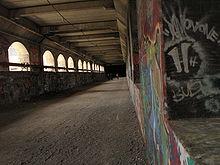
The former canal and subway tunnels have become a frequent source of debate. Several city homeless use the tunnels for shelter, and a few areas near tunnel entrances have gained the reputation as being dangerous. The city has considered multiple solutions for the space including recreating a canal way, putting the subway system back in or filling the tunnels entirely. The plan to fill the tunnels in completely has generated criticism as the cost of filling would not generate nor leverage economic development.
Public support continues to grow for re-watering the original Erie Canal through downtown Rochester. In support of the re-watering efforts, the City released a master plan in 2009 calling for the creation of Rochester's Historic Canal District. A subsequent environmental review documment is set to be released in the near future, seeking additional public input. This district includes both private and public investment that builds upon the rich heritage of the district, educational opportuniites, historic interpretation, architectural significant building and recreational amenities. The City is currently seeking public funds for implementing the first of three major phases of the Canal District.
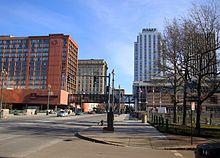
There are three exits off the New York State Thruway (Interstate 90) that serve Rochester. Rochester has an extensive system of limited-access highways (called 'freeways' and 'expresssways') which connects all parts of the city and the Thruway. During the Thruway's construction, a disagreement between the governor of New York and mayor of Rochester resulted in a bypass of downtown Rochester, leaving the city struggling for growth.
Rochester's expressway system, conceived in the 1950s, was designed as two concentric circles with feeder expressways from the west, south and east. The system allows for quick travel within the metropolitan area and a lack of the traffic gridlock typically found in cities of comparable size; in part this is because the system was designed to accommodate an anticipated year-2000 metro population of 5 million, whereas the present-day population is just over one million.
The Outer Loop circles just outside the city limits while the Inner Loop circles around the immediate downtown area within the city. From the west are Lake Ontario State Parkway, NY-531 and I-490; Interstate 390 feeds from the south; and NY-104, NY-441, and I-490 approach from the east.
Three Interstate Highways run through the City of Rochester:
 Interstate 390 (Genesee Expressway)
Interstate 390 (Genesee Expressway)
 Interstate 490 (Western/Eastern Expressway)
Interstate 490 (Western/Eastern Expressway)
 Interstate 590
Interstate 590
New York State Route Expressways:
 New York State Route 104 (Irondequoit-Wayne County Expressway, West Ridge Road)
New York State Route 104 (Irondequoit-Wayne County Expressway, West Ridge Road)
 New York State Route 390
New York State Route 390
 New York State Route 590
New York State Route 590
 Inner Loop
Inner Loop
New York State Parkways:
 Lake Ontario State Parkway
Lake Ontario State Parkway
Rochester has twelve sister cities, as designated by Sister Cities International. They are all dedicated by a branched concrete walkway over the Genesee River, dubbed the Sister Cities Bridge (known as the Frank and Janet Lamb Bridge since October 2006):[100]
Word Count: 8394






